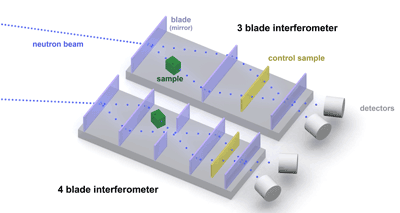Sensor improvement brings analysis method into mainstream
A team of researchers at the National Institute of Standards and Technology and the University of Waterloo’s Institute of Quantum Computing announced that a new advancement in sensor design could unshackle a power technique for exploring materials. The team hopes that this development could expand the technique – called neutron interferometry — from a test of quantum mechanics to a tool for industry as well.
Neutron beams can be used in many ways to probe complex molecules and other advanced materials, but only a few of the analysis techniques require as much care as neutron interferometry. With this technique neutrons are treated as waves (a feature of quantum mechanics). This technique measures how the neutron is altered as it passes through a sample material. This can show details about the magnetic, nuclear, and structural properties of the sample.

While the interferometer’s original 3-blade version requires extensive shielding from vibration and changes in temperature, the newly designed 4-blade version will be far less susceptible to these environmental influences, allowing the NIST team to place it much closer to the neutron source and thereby reducing the time needed for many experiments by a factor of 10 or more.
Not only neutron interferometry is so sensitive, but is also comes with a price. The instruments used are also sensitive to vibration and must be built in a blockhouse the size of a garage in order to be shield from seismic activity. The instruments are also sensitive to temperature and need to be maintained at temperatures that are stable to within a few thousandths of a degree Celsius.
The NIST team was able to render the interferometer to be much more tolerant of change. Basically the core of a classic neutron interferometer is a small piece of silicon about the size of a soda can, accurately machined so that three thin walls of silicon jut upwards from its surface. These walls diffract the neutron beam, splitting it in two, sending one part through the sample. The newly innovation is to add an extra wall in a way that increases the overall symmetry of the interferometer.
“By adding a fourth vane to the usual three, we were effectively able to cancel out the effect of many disturbances,” says Michael Huber of the NIST research team. “It will allow us to create a device that can be housed in a box the size of a large charcoal grill that sits on the floor.” This means that the new device will be much closer to the neutron source and according to Huber it will deliver more than 10 times as many neutrons on the sample as before and generating data that is far more accurate in a fraction of the time.
A measurement that might have taken more than a week could be done in a matter of hours now,” Huber says. “We can imagine our interferometer becoming more of a 'user facility' that industry and universities can book time on when needed, rather than the esoteric instrument it has been up to this point. This development in neutron interferometry demonstrates that quantum technologies have the potential to emerge from academia to help build practical devices for real-world applications.”
Huber adds that the NCNR will still maintain the original blockhouse-style instrument for certain types of interferometry work, but will augment it with the new device, which could start taking measurements when the NCNR resumes neutron production after its expansion project is complete in February 2012. More info can be found on www.nist.gov.
Christina Nickolas
Advertisement
Learn more about National Institute of Standards and Technology





